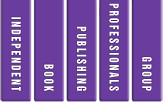In an article at CNN.com titled "If it's cool, creative, and different, it's indie," journalist Catherine Andrews wrote:
"The term 'indie' traditionally refers to independent art -- music, film, literature or anything that fits under the broad banner of culture -- created outside of the mainstream and without corporate financing."
Although many independent book publishing companies are incorporated, they are independent of the major conglomerates that dominate the book publishing industry. Independent book publishers include small presses, mid-size independent publishers, university presses, e-book publishers, and self-published authors.
Like other independent artists, many indie book publishers face challenges that the industry giants don't experience. We typically have to work a lot harder to get our books into retail stores (or our authors onto Oprah) and ultimately into the hands of readers. As Chris Anderson reports in his bestselling business book The Long Tail:
"More than 99 percent of music albums on the market today are not available in Wal-Mart. ... Same for any other leading retailer and practically any other commodity [including] books... The vast majority of products are not available at a store near you."
Yet independent book publishing is thriving in spite of the challenges.
According to recent statistics collected by Zippia.com, the U.S. book industry made $28.1 billion in revenue in 2022. Over 4 million new books were published in 2022 alone, with 2.1 million of those being self-published. Romance is the most popular genre of books sold in the U.S., achieving over 32 million print copies sold in 2022.
The overwhelming number of new books, combined with the millions of titles already in print, makes it difficult for booksellers, librarians, and consumers to identify books that are worth buying and reading - especially when those books are not published by companies with multimillion dollar marketing budgets.
As Chris Anderson reports in his best-selling business book The Long Tail: "More than 99 percent of music albums on the market today are not available in Wal-Mart. … Same for any other leading retailer and practically any other commodity [including] books… The vast majority of products are not available at a store near you."


